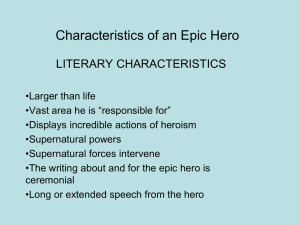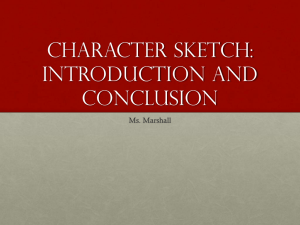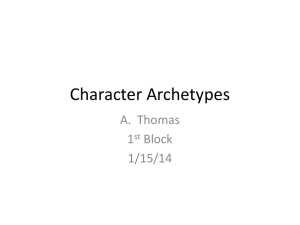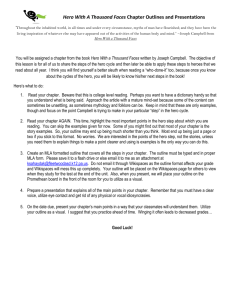Hero`s Journey Information in this handout is from a Prezi
advertisement
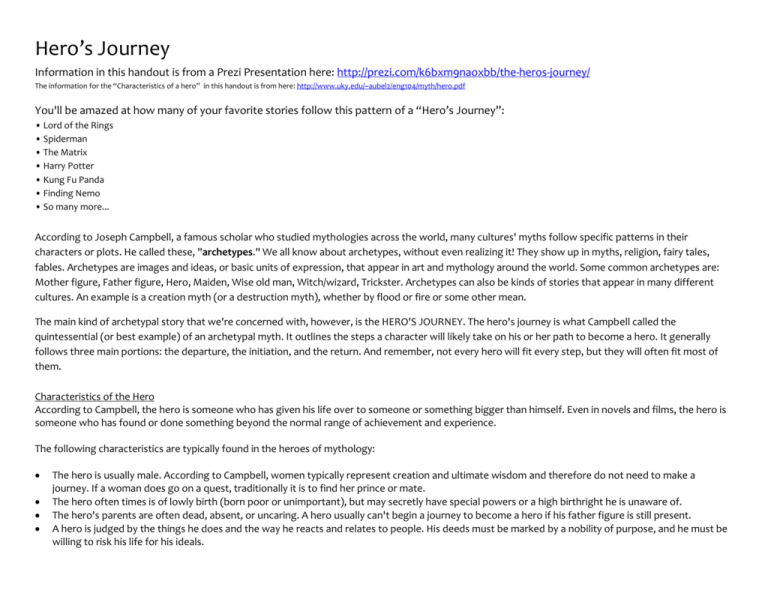
Hero’s Journey Information in this handout is from a Prezi Presentation here: http://prezi.com/k6bxm9naoxbb/the-heros-journey/ The information for the “Characteristics of a hero” in this handout is from here: http://www.uky.edu/~aubel2/eng104/myth/hero.pdf You'll be amazed at how many of your favorite stories follow this pattern of a “Hero’s Journey”: • Lord of the Rings • Spiderman • The Matrix • Harry Potter • Kung Fu Panda • Finding Nemo • So many more... According to Joseph Campbell, a famous scholar who studied mythologies across the world, many cultures' myths follow specific patterns in their characters or plots. He called these, "archetypes." We all know about archetypes, without even realizing it! They show up in myths, religion, fairy tales, fables. Archetypes are images and ideas, or basic units of expression, that appear in art and mythology around the world. Some common archetypes are: Mother figure, Father figure, Hero, Maiden, Wise old man, Witch/wizard, Trickster. Archetypes can also be kinds of stories that appear in many different cultures. An example is a creation myth (or a destruction myth), whether by flood or fire or some other mean. The main kind of archetypal story that we're concerned with, however, is the HERO'S JOURNEY. The hero's journey is what Campbell called the quintessential (or best example) of an archetypal myth. It outlines the steps a character will likely take on his or her path to become a hero. It generally follows three main portions: the departure, the initiation, and the return. And remember, not every hero will fit every step, but they will often fit most of them. Characteristics of the Hero According to Campbell, the hero is someone who has given his life over to someone or something bigger than himself. Even in novels and films, the hero is someone who has found or done something beyond the normal range of achievement and experience. The following characteristics are typically found in the heroes of mythology: The hero is usually male. According to Campbell, women typically represent creation and ultimate wisdom and therefore do not need to make a journey. If a woman does go on a quest, traditionally it is to find her prince or mate. The hero often times is of lowly birth (born poor or unimportant), but may secretly have special powers or a high birthright he is unaware of. The hero's parents are often dead, absent, or uncaring. A hero usually can't begin a journey to become a hero if his father figure is still present. A hero is judged by the things he does and the way he reacts and relates to people. His deeds must be marked by a nobility of purpose, and he must be willing to risk his life for his ideals. Steps of Hero’s Journey Part 1: Initiation Description of the step This is the start of the Hero’s journey. Step 1: Unusual Birth (or unusual Early Childhood) There is something unusual about the hero's birth or childhood – something that make him different from other people. Step 2: Call to Adventure The hero's call to adventure is something that spurs him or her to action. Hero is forced to leave everyday world/life. The hero may at first reject the call, but he will eventually come around and decide he has to take action. This acceptance is the hero's first voluntary step. Step 3: Crossing the Threshold The threshold is the boundary between the life the hero has known before and the unknown challenges that await him. Behind him is his home and his past life – before him is uncertainty and danger. Crossing the threshold, then, is when the hero takes the first steps on his adventure, leaving home and setting off on his journey. Steps of Hero’s Journey Part 2: Growth Step 4: The Challenges or Trials Description of the step This part contains most of the rising action and excitement. The challenges make up the bulk of the hero's journey. They are the things the hero must overcome, the Your notes (or analysis) Your notes (or analysis) Step 5: Supernatural Helper or Mentor monsters the hero must fight and the battles the hero must win, in order to complete his journey. The hero usually has a mentor who looks out for him, teaches him what he needs to know, gives him advice and guidance, and maybe even gives the hero a weapon or magical object: a pen from a mentor, a magical sword named Excaliber, his father's lightsaber, or even a wand chosen just for him. Unfortunately, the mentor usually also has to be out of the picture in order for the hero to come into his own and truly show his worth. For this reason, mentors have to leave the hero in one way or another – and they often end up dying. Step 6: The Special Weapon The hero also has a weapon, often one that only he can yield. This may be something given to him by the mentor, or perhaps something he has to earn. Step 7: The Abyss or Temptation Here's where things get tricky for our hero. An abyss is defined as "an immeasurably deep chasm, depth, or void." So, the abyss is the darkest, most perilous part of the hero's journey. They may even face the temptation to become evil or to desert their quest. This is the point where the hero achieves his goal, wins the battle, finishes the quest, saves the girl, kills the bad guy. Step 8: The Transformation The hero is changed by his experiences. He becomes a true hero. Steps of Hero’s Journey Part 3: Stronger Description of the step Finally, the character is ready to return home and claim his place as a true hero. His journey is coming to a close. Step 9: The Return Home This step is pretty much just what it sounds like. In order to prove himself a changed person and a true hero, the hero must return home. He may decide not stay there, but he will usually return at least temporarily. (Not all heroes can do this. For instance, Frodo, in Lord of the Rings, cannot go back to his old world and instead chooses to go join the elves.) Step 10: The Mastery of Two Worlds This final step refers to the hero's ability to reconcile his experiences on his journey with his life back home. He has seen and learned things that have changed him. How can he live in the world he is used to, but still stay true to his new role as a hero? Vocabulary Literary terms: From the textbook or short story selection: Your notes (or analysis) Here are some other ways to look at these Hero steps. They are all basically the same, with perhaps a different name or a few more steps with further details. picture: http://resonantinsights.com/2012/12/honor-your-heros-journey/ Supplemental: More Hero’s Journey depictions… You as the HERO!


